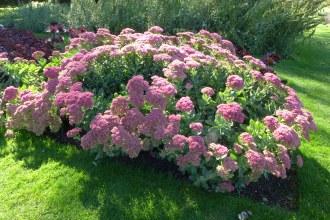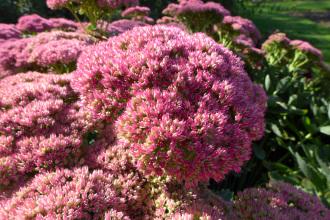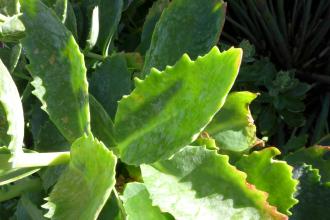
Sedum (Herbstfreude Group) ‘Herbstfreude’ (19/09/2015, Kew Gardens, London)
Position: Full sun to partial shade
Flowering period: Late summer to early autumn
Soil: Moist, well drained
Eventual Height: 1m
Eventual Spread: 50cm
Hardiness: 3a, 3b, 4a, 4b, 5a, 5b, 6a, 6b, 7a, 7b, 8a, 8b, 9a, 9b
Family: Crassulaceae
Sedum ‘Herbstfreude’ is a fast growing, compact, deciduous, herbaceous perennial with a clump forming habit. Its bright green fleshy leaves are ovate to linear with serrate margins, are up to 6cm long and 3cm across. Its stems are green in color. Its pale to bright pink flowers appear en mass in flat terminal cymes and are up to 10cm across. Its seed heads are held into the winter without breaking apart

Sedum (Herbstfreude Group) ‘Herbstfreude’ Flower (19/09/2015, Kew Gardens, London)
Sedum ‘Herbstfreude’, commonly known as Stonecrop ‘Herbstfreude’, was possibly first grown by Georg Arrends (1863-1952) nursery at Wuppertal Germany near Cologne and is a hybrid between Sedum spectabile and Sedum telephium. Sedum ‘Herbstfreude’ is synonymous with Hylotelephium spectabile ‘Indian Chief’ and Sedum spectabile ‘Autumn Joy’.
The etymological root of the binomial name Sedum is derived from the Latin sedo meaning ‘settle’, a name used by Pliny describing how the cushion species of this genus hug the rocks. ‘Herbstfreude’ is from German, translating as ‘Autumn Joy’.
The landscape architect may find Sedum ‘Herbstfreude’ useful in informal prairie type scheme or as part of a mixed herbaceous planting scheme. Once established this plant is drought tolerant.

Sedum (Herbstfreude Group) ‘Herbstfreude’ Leaf (19/09/2015, Kew Gardens, London)
Ecologically, Sedum ‘Herbstfreude’ flowers are attractive to pollinating insects, including bees. However this plant is sterile and does not produce nectar.
The Royal Horticultural Society has given Sedum (Herbstfreude Group) ‘Herbstfreude’ their prestigious Award of Garden Merit in 1993.
Sedum ‘Herbstfreude’ prefers moist, fertile, well-drained soils. It prefers a neutral to alkali pH of soil.
Sedum ‘Herbstfreude’ requires little maintenance. Dead flower heads may be retained on the plant throughout the winter months to provide winter interest and cut off in early spring. Large clumps may be divided in spring.

Landscape Architecture

